MGT200 Organizational Behavior: Why Not Practice Democracy?
VerifiedAdded on 2023/06/07
|5
|1423
|323
Essay
AI Summary
This essay presents a detailed argument against the practice of organizational democracy, asserting that despite its theoretical benefits, it poses significant challenges to organizational structure and efficiency. The essay highlights potential issues such as confusion in decision-making, misuse of power by employees, cross-cultural conflicts, and the undermining of skilled leadership. It suggests that while inclusivity is important, a completely democratic approach can disrupt established hierarchies and create opportunities for exploitation and discord. The essay concludes that implementing democratic practices may lead to more problems than solutions, emphasizing the importance of maintaining a balanced organizational structure that values expertise and experience. Desklib provides access to this and other solved assignments to aid student learning.
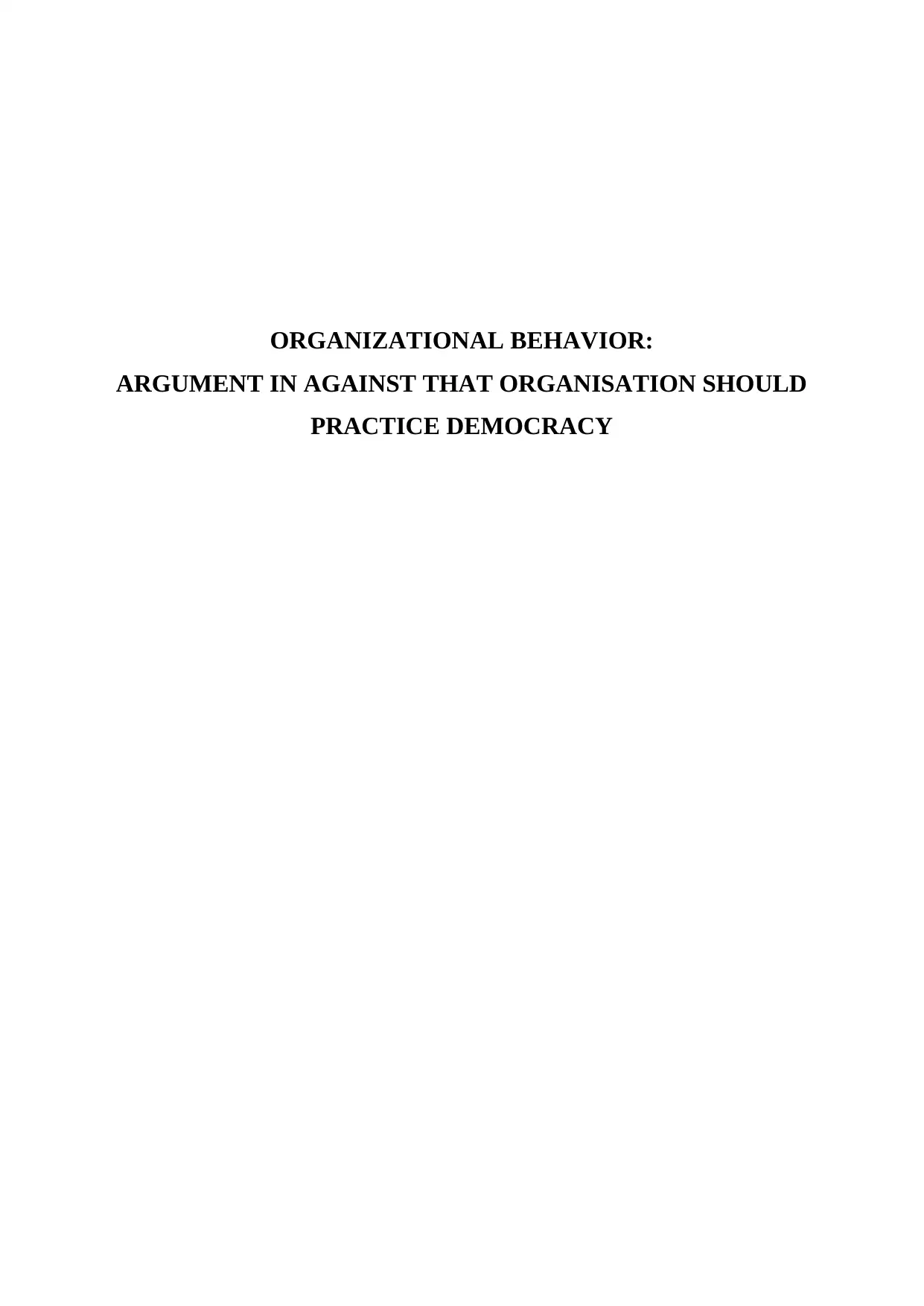
ORGANIZATIONAL BEHAVIOR:
ARGUMENT IN AGAINST THAT ORGANISATION SHOULD
PRACTICE DEMOCRACY
ARGUMENT IN AGAINST THAT ORGANISATION SHOULD
PRACTICE DEMOCRACY
Paraphrase This Document
Need a fresh take? Get an instant paraphrase of this document with our AI Paraphraser
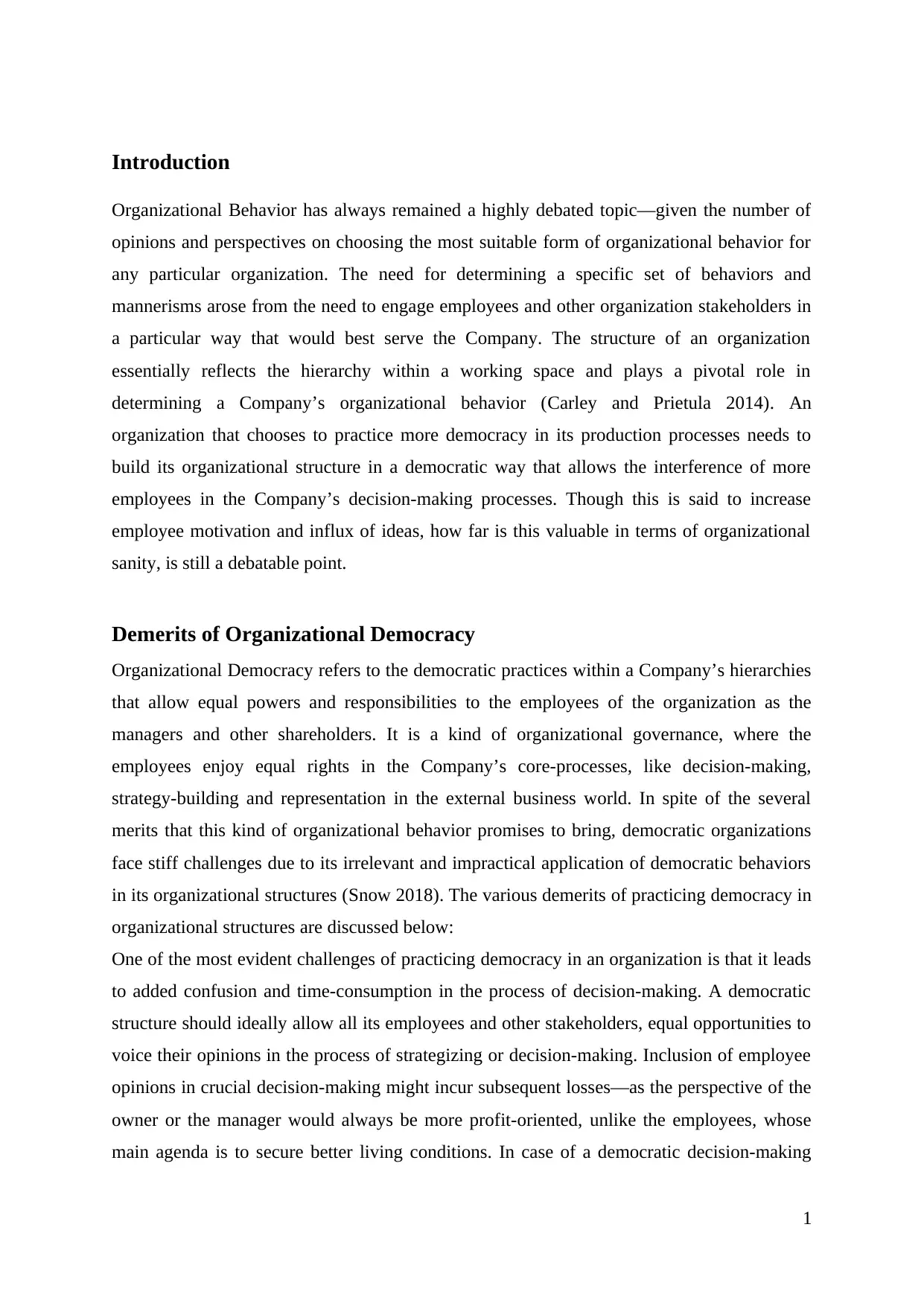
Introduction
Organizational Behavior has always remained a highly debated topic—given the number of
opinions and perspectives on choosing the most suitable form of organizational behavior for
any particular organization. The need for determining a specific set of behaviors and
mannerisms arose from the need to engage employees and other organization stakeholders in
a particular way that would best serve the Company. The structure of an organization
essentially reflects the hierarchy within a working space and plays a pivotal role in
determining a Company’s organizational behavior (Carley and Prietula 2014). An
organization that chooses to practice more democracy in its production processes needs to
build its organizational structure in a democratic way that allows the interference of more
employees in the Company’s decision-making processes. Though this is said to increase
employee motivation and influx of ideas, how far is this valuable in terms of organizational
sanity, is still a debatable point.
Demerits of Organizational Democracy
Organizational Democracy refers to the democratic practices within a Company’s hierarchies
that allow equal powers and responsibilities to the employees of the organization as the
managers and other shareholders. It is a kind of organizational governance, where the
employees enjoy equal rights in the Company’s core-processes, like decision-making,
strategy-building and representation in the external business world. In spite of the several
merits that this kind of organizational behavior promises to bring, democratic organizations
face stiff challenges due to its irrelevant and impractical application of democratic behaviors
in its organizational structures (Snow 2018). The various demerits of practicing democracy in
organizational structures are discussed below:
One of the most evident challenges of practicing democracy in an organization is that it leads
to added confusion and time-consumption in the process of decision-making. A democratic
structure should ideally allow all its employees and other stakeholders, equal opportunities to
voice their opinions in the process of strategizing or decision-making. Inclusion of employee
opinions in crucial decision-making might incur subsequent losses—as the perspective of the
owner or the manager would always be more profit-oriented, unlike the employees, whose
main agenda is to secure better living conditions. In case of a democratic decision-making
1
Organizational Behavior has always remained a highly debated topic—given the number of
opinions and perspectives on choosing the most suitable form of organizational behavior for
any particular organization. The need for determining a specific set of behaviors and
mannerisms arose from the need to engage employees and other organization stakeholders in
a particular way that would best serve the Company. The structure of an organization
essentially reflects the hierarchy within a working space and plays a pivotal role in
determining a Company’s organizational behavior (Carley and Prietula 2014). An
organization that chooses to practice more democracy in its production processes needs to
build its organizational structure in a democratic way that allows the interference of more
employees in the Company’s decision-making processes. Though this is said to increase
employee motivation and influx of ideas, how far is this valuable in terms of organizational
sanity, is still a debatable point.
Demerits of Organizational Democracy
Organizational Democracy refers to the democratic practices within a Company’s hierarchies
that allow equal powers and responsibilities to the employees of the organization as the
managers and other shareholders. It is a kind of organizational governance, where the
employees enjoy equal rights in the Company’s core-processes, like decision-making,
strategy-building and representation in the external business world. In spite of the several
merits that this kind of organizational behavior promises to bring, democratic organizations
face stiff challenges due to its irrelevant and impractical application of democratic behaviors
in its organizational structures (Snow 2018). The various demerits of practicing democracy in
organizational structures are discussed below:
One of the most evident challenges of practicing democracy in an organization is that it leads
to added confusion and time-consumption in the process of decision-making. A democratic
structure should ideally allow all its employees and other stakeholders, equal opportunities to
voice their opinions in the process of strategizing or decision-making. Inclusion of employee
opinions in crucial decision-making might incur subsequent losses—as the perspective of the
owner or the manager would always be more profit-oriented, unlike the employees, whose
main agenda is to secure better living conditions. In case of a democratic decision-making
1
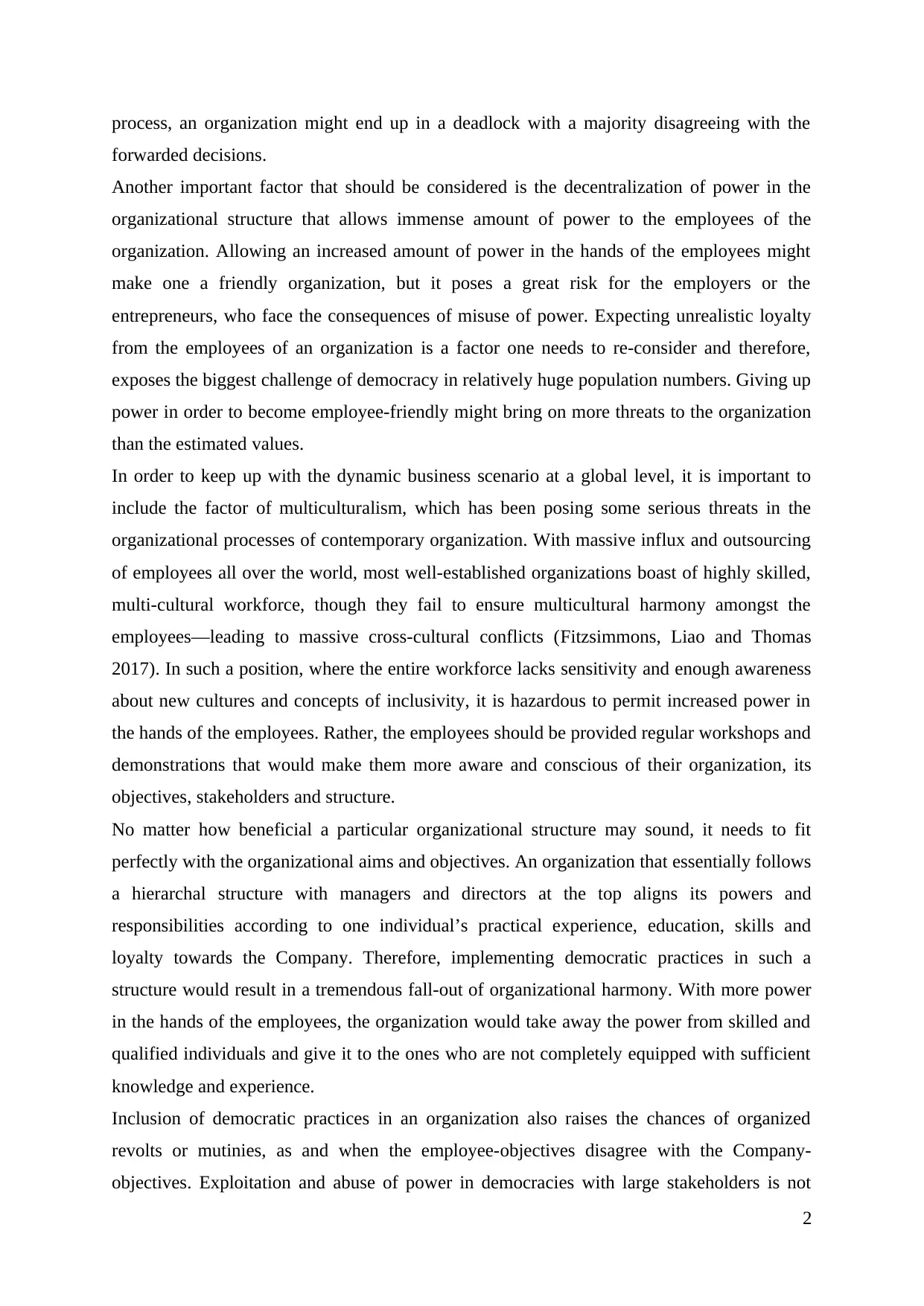
process, an organization might end up in a deadlock with a majority disagreeing with the
forwarded decisions.
Another important factor that should be considered is the decentralization of power in the
organizational structure that allows immense amount of power to the employees of the
organization. Allowing an increased amount of power in the hands of the employees might
make one a friendly organization, but it poses a great risk for the employers or the
entrepreneurs, who face the consequences of misuse of power. Expecting unrealistic loyalty
from the employees of an organization is a factor one needs to re-consider and therefore,
exposes the biggest challenge of democracy in relatively huge population numbers. Giving up
power in order to become employee-friendly might bring on more threats to the organization
than the estimated values.
In order to keep up with the dynamic business scenario at a global level, it is important to
include the factor of multiculturalism, which has been posing some serious threats in the
organizational processes of contemporary organization. With massive influx and outsourcing
of employees all over the world, most well-established organizations boast of highly skilled,
multi-cultural workforce, though they fail to ensure multicultural harmony amongst the
employees—leading to massive cross-cultural conflicts (Fitzsimmons, Liao and Thomas
2017). In such a position, where the entire workforce lacks sensitivity and enough awareness
about new cultures and concepts of inclusivity, it is hazardous to permit increased power in
the hands of the employees. Rather, the employees should be provided regular workshops and
demonstrations that would make them more aware and conscious of their organization, its
objectives, stakeholders and structure.
No matter how beneficial a particular organizational structure may sound, it needs to fit
perfectly with the organizational aims and objectives. An organization that essentially follows
a hierarchal structure with managers and directors at the top aligns its powers and
responsibilities according to one individual’s practical experience, education, skills and
loyalty towards the Company. Therefore, implementing democratic practices in such a
structure would result in a tremendous fall-out of organizational harmony. With more power
in the hands of the employees, the organization would take away the power from skilled and
qualified individuals and give it to the ones who are not completely equipped with sufficient
knowledge and experience.
Inclusion of democratic practices in an organization also raises the chances of organized
revolts or mutinies, as and when the employee-objectives disagree with the Company-
objectives. Exploitation and abuse of power in democracies with large stakeholders is not
2
forwarded decisions.
Another important factor that should be considered is the decentralization of power in the
organizational structure that allows immense amount of power to the employees of the
organization. Allowing an increased amount of power in the hands of the employees might
make one a friendly organization, but it poses a great risk for the employers or the
entrepreneurs, who face the consequences of misuse of power. Expecting unrealistic loyalty
from the employees of an organization is a factor one needs to re-consider and therefore,
exposes the biggest challenge of democracy in relatively huge population numbers. Giving up
power in order to become employee-friendly might bring on more threats to the organization
than the estimated values.
In order to keep up with the dynamic business scenario at a global level, it is important to
include the factor of multiculturalism, which has been posing some serious threats in the
organizational processes of contemporary organization. With massive influx and outsourcing
of employees all over the world, most well-established organizations boast of highly skilled,
multi-cultural workforce, though they fail to ensure multicultural harmony amongst the
employees—leading to massive cross-cultural conflicts (Fitzsimmons, Liao and Thomas
2017). In such a position, where the entire workforce lacks sensitivity and enough awareness
about new cultures and concepts of inclusivity, it is hazardous to permit increased power in
the hands of the employees. Rather, the employees should be provided regular workshops and
demonstrations that would make them more aware and conscious of their organization, its
objectives, stakeholders and structure.
No matter how beneficial a particular organizational structure may sound, it needs to fit
perfectly with the organizational aims and objectives. An organization that essentially follows
a hierarchal structure with managers and directors at the top aligns its powers and
responsibilities according to one individual’s practical experience, education, skills and
loyalty towards the Company. Therefore, implementing democratic practices in such a
structure would result in a tremendous fall-out of organizational harmony. With more power
in the hands of the employees, the organization would take away the power from skilled and
qualified individuals and give it to the ones who are not completely equipped with sufficient
knowledge and experience.
Inclusion of democratic practices in an organization also raises the chances of organized
revolts or mutinies, as and when the employee-objectives disagree with the Company-
objectives. Exploitation and abuse of power in democracies with large stakeholders is not
2
⊘ This is a preview!⊘
Do you want full access?
Subscribe today to unlock all pages.

Trusted by 1+ million students worldwide
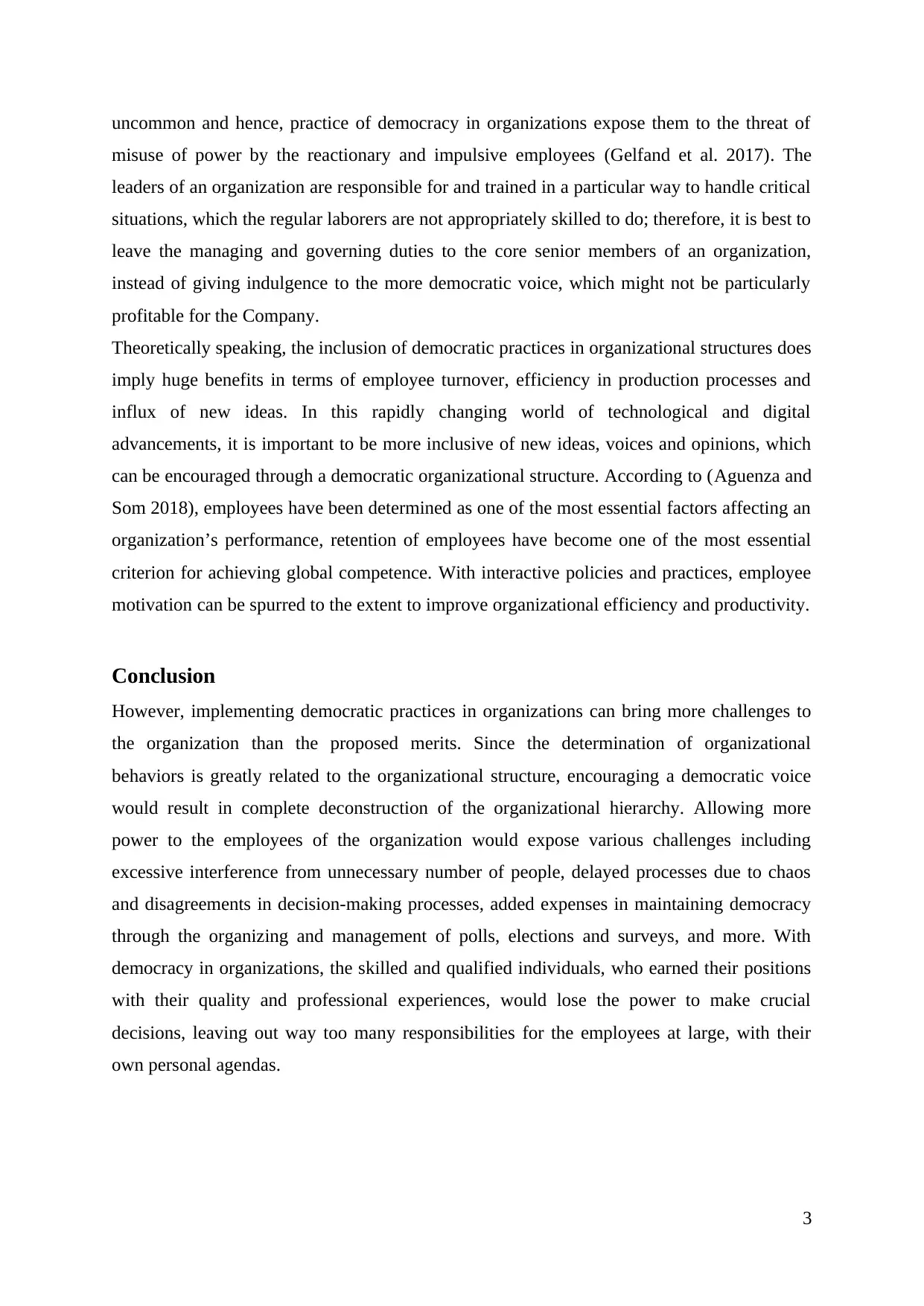
uncommon and hence, practice of democracy in organizations expose them to the threat of
misuse of power by the reactionary and impulsive employees (Gelfand et al. 2017). The
leaders of an organization are responsible for and trained in a particular way to handle critical
situations, which the regular laborers are not appropriately skilled to do; therefore, it is best to
leave the managing and governing duties to the core senior members of an organization,
instead of giving indulgence to the more democratic voice, which might not be particularly
profitable for the Company.
Theoretically speaking, the inclusion of democratic practices in organizational structures does
imply huge benefits in terms of employee turnover, efficiency in production processes and
influx of new ideas. In this rapidly changing world of technological and digital
advancements, it is important to be more inclusive of new ideas, voices and opinions, which
can be encouraged through a democratic organizational structure. According to (Aguenza and
Som 2018), employees have been determined as one of the most essential factors affecting an
organization’s performance, retention of employees have become one of the most essential
criterion for achieving global competence. With interactive policies and practices, employee
motivation can be spurred to the extent to improve organizational efficiency and productivity.
Conclusion
However, implementing democratic practices in organizations can bring more challenges to
the organization than the proposed merits. Since the determination of organizational
behaviors is greatly related to the organizational structure, encouraging a democratic voice
would result in complete deconstruction of the organizational hierarchy. Allowing more
power to the employees of the organization would expose various challenges including
excessive interference from unnecessary number of people, delayed processes due to chaos
and disagreements in decision-making processes, added expenses in maintaining democracy
through the organizing and management of polls, elections and surveys, and more. With
democracy in organizations, the skilled and qualified individuals, who earned their positions
with their quality and professional experiences, would lose the power to make crucial
decisions, leaving out way too many responsibilities for the employees at large, with their
own personal agendas.
3
misuse of power by the reactionary and impulsive employees (Gelfand et al. 2017). The
leaders of an organization are responsible for and trained in a particular way to handle critical
situations, which the regular laborers are not appropriately skilled to do; therefore, it is best to
leave the managing and governing duties to the core senior members of an organization,
instead of giving indulgence to the more democratic voice, which might not be particularly
profitable for the Company.
Theoretically speaking, the inclusion of democratic practices in organizational structures does
imply huge benefits in terms of employee turnover, efficiency in production processes and
influx of new ideas. In this rapidly changing world of technological and digital
advancements, it is important to be more inclusive of new ideas, voices and opinions, which
can be encouraged through a democratic organizational structure. According to (Aguenza and
Som 2018), employees have been determined as one of the most essential factors affecting an
organization’s performance, retention of employees have become one of the most essential
criterion for achieving global competence. With interactive policies and practices, employee
motivation can be spurred to the extent to improve organizational efficiency and productivity.
Conclusion
However, implementing democratic practices in organizations can bring more challenges to
the organization than the proposed merits. Since the determination of organizational
behaviors is greatly related to the organizational structure, encouraging a democratic voice
would result in complete deconstruction of the organizational hierarchy. Allowing more
power to the employees of the organization would expose various challenges including
excessive interference from unnecessary number of people, delayed processes due to chaos
and disagreements in decision-making processes, added expenses in maintaining democracy
through the organizing and management of polls, elections and surveys, and more. With
democracy in organizations, the skilled and qualified individuals, who earned their positions
with their quality and professional experiences, would lose the power to make crucial
decisions, leaving out way too many responsibilities for the employees at large, with their
own personal agendas.
3
Paraphrase This Document
Need a fresh take? Get an instant paraphrase of this document with our AI Paraphraser
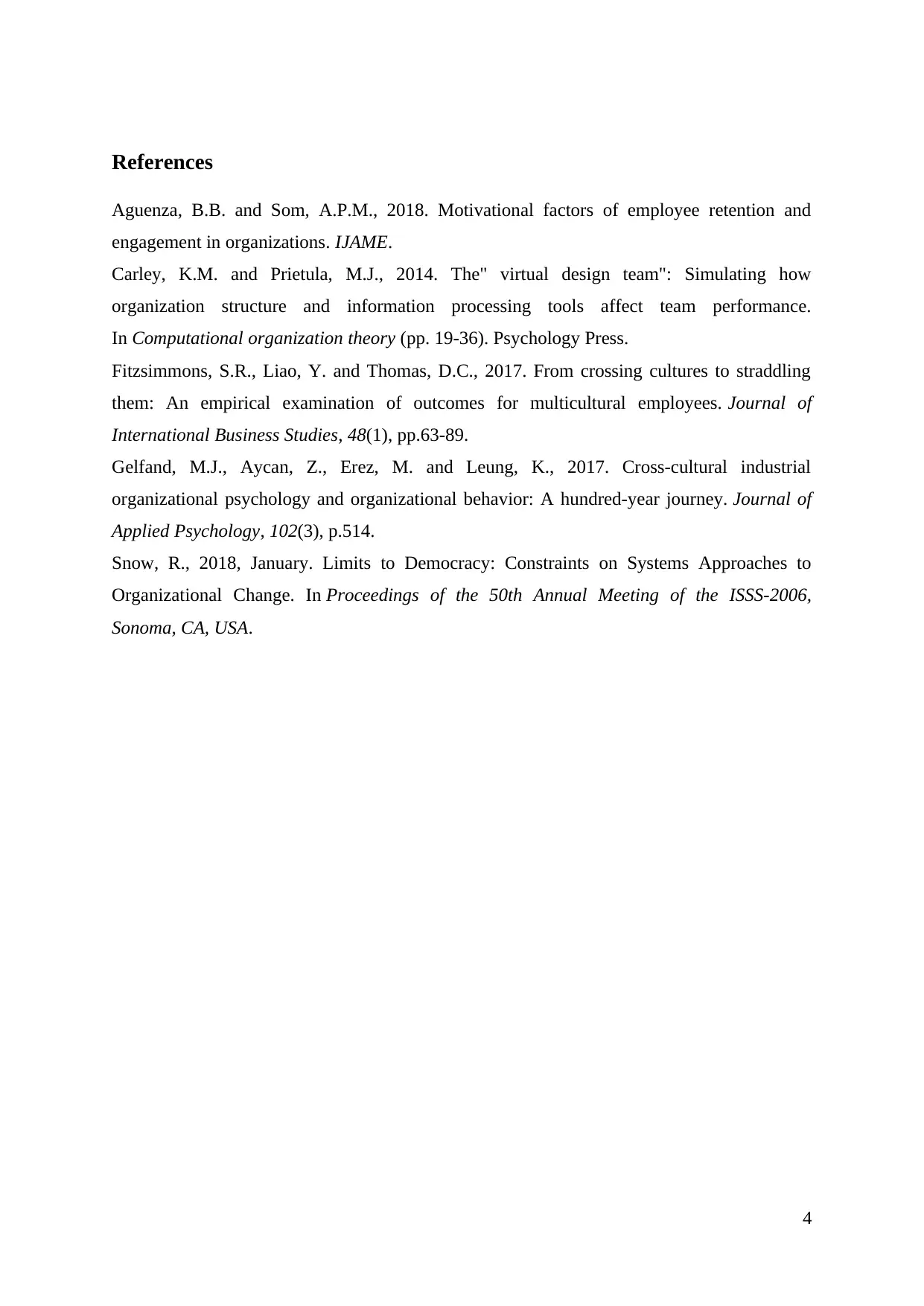
References
Aguenza, B.B. and Som, A.P.M., 2018. Motivational factors of employee retention and
engagement in organizations. IJAME.
Carley, K.M. and Prietula, M.J., 2014. The" virtual design team": Simulating how
organization structure and information processing tools affect team performance.
In Computational organization theory (pp. 19-36). Psychology Press.
Fitzsimmons, S.R., Liao, Y. and Thomas, D.C., 2017. From crossing cultures to straddling
them: An empirical examination of outcomes for multicultural employees. Journal of
International Business Studies, 48(1), pp.63-89.
Gelfand, M.J., Aycan, Z., Erez, M. and Leung, K., 2017. Cross-cultural industrial
organizational psychology and organizational behavior: A hundred-year journey. Journal of
Applied Psychology, 102(3), p.514.
Snow, R., 2018, January. Limits to Democracy: Constraints on Systems Approaches to
Organizational Change. In Proceedings of the 50th Annual Meeting of the ISSS-2006,
Sonoma, CA, USA.
4
Aguenza, B.B. and Som, A.P.M., 2018. Motivational factors of employee retention and
engagement in organizations. IJAME.
Carley, K.M. and Prietula, M.J., 2014. The" virtual design team": Simulating how
organization structure and information processing tools affect team performance.
In Computational organization theory (pp. 19-36). Psychology Press.
Fitzsimmons, S.R., Liao, Y. and Thomas, D.C., 2017. From crossing cultures to straddling
them: An empirical examination of outcomes for multicultural employees. Journal of
International Business Studies, 48(1), pp.63-89.
Gelfand, M.J., Aycan, Z., Erez, M. and Leung, K., 2017. Cross-cultural industrial
organizational psychology and organizational behavior: A hundred-year journey. Journal of
Applied Psychology, 102(3), p.514.
Snow, R., 2018, January. Limits to Democracy: Constraints on Systems Approaches to
Organizational Change. In Proceedings of the 50th Annual Meeting of the ISSS-2006,
Sonoma, CA, USA.
4
1 out of 5
Related Documents
Your All-in-One AI-Powered Toolkit for Academic Success.
+13062052269
info@desklib.com
Available 24*7 on WhatsApp / Email
![[object Object]](/_next/static/media/star-bottom.7253800d.svg)
Unlock your academic potential
Copyright © 2020–2025 A2Z Services. All Rights Reserved. Developed and managed by ZUCOL.





